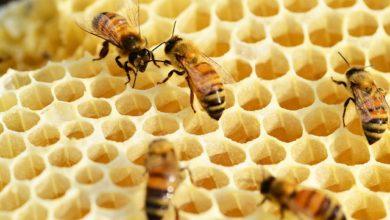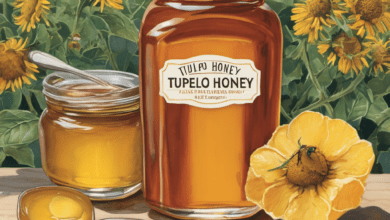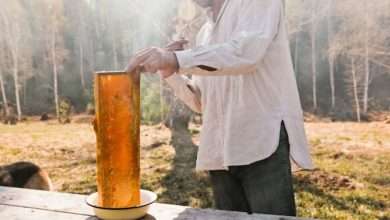Honey Bee Nectar Collection

Most people do not take into account the various payloads that come on the landing board while picturing diligent honey bees hauling home buckets of nectar. Indeed, pollen, water, and propolis are the other three things honey bees gather.
This article will focus on the nectar collection.
According to the species, different locations in a flower are home to glands known as floral nectaries that secrete nectar in most cases. They may be on the sepals, petals, stamens, or base of the flower, although they are typically toward the base. Pollen adheres to the bodies of foraging bees as they delve deep inside the bloom in search of the sweet juice.
Honey bees usually only stop at one type of flower during a foraging journey. She unintentionally gathers more pollen grains as she moves from flower to bloom, and some of the older grains end up on the anthers of the following flower. Cross-pollination has happened rather unintentionally, at least from the bee’s point of view.
How do bees get the nectar out of the flower?
Mandibles and the tongue-like proboscis make up the honey bee’s mouthparts. When the worker approaches a flower, she extends the proboscis, which is usually tucked under her “chin,” and places it into the area of the flower where the nectar lies.
The bee sucks till she has gotten every drop of nectar within her grasp after finding it. She stores the nectar in a honey sac, which functions as a second stomach until she goes back to the colony. Worker bees in the hive get the nectar load, which they then use to fill their proboscis with nectar that they suck from the honey sac. When the nectar is ready to be stored in a honeycomb cell, they process it by adding enzymes.
Flowers and bees are thought to have coevolved, together. The strongest, most beautiful nectar was produced by the plants that lived, and it was also the sweetest. The plants most likely to be pollinated and give rise to the following generation were those that attracted the bees more.
A plant-pollinator mutualism is what biologists refer to as this phenomenon, in which both the plant and the bee benefit from each other’s presence and develop a closer relationship over time. A single species can pollinate a specific type of flower in some mutualisms, which are quite precise. These mutualisms have attracted a lot of interest lately because when one partner goes extinct, the other one does too.
What time do bees like to collect nectar?
Just before daylight, they are flitting about. When the flowers still have dew on them and the pollen is damp, it is essential to collect nectar early in the morning.
Flowers have evolved further specialized methods over around 80 million years to entice bees, such as colored petals, distinctive patterns termed “honey guides,” and landing platforms-widened or fused lower petals that facilitate a visit for the bee. T
he pollinators find many of the patterns to be incredibly alluring while being ultraviolet-visible to humans. The bees then evolved brushy bodies that catch the pollen and bristly legs that can be used like combs to scrape pollen from their abdomens. The bees also evolved tube-like mouthparts that can reach deep inside a blossom like a straw.
What flower produces the most nectar for bees?
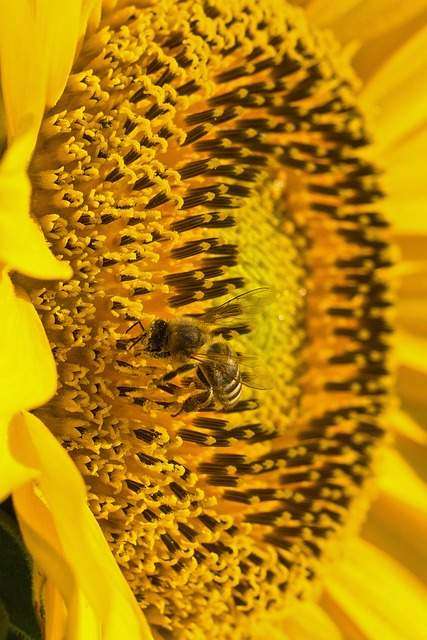
- Torch Lily
- Bee Balm
- Lavender
- Spider Flower
- Salvia
- Catmint
- Beardtongue
- Fuschia
The “honey stomach,” a portion of the esophagus that enlarges as it fills, is where the nectar is swallowed. After the honey’s stomach is full, the bee returns to the hive and engages in a procedure known as trophallaxis to transfer the burden to an eager worker. The protracted process of turning nectar into honey starts once it is in the hands—or, more precisely, the honey stomach—of an in-hive worker.
FAQs
How is nectar collected?
- From flowers, bees get nectar. Nectar is the tasty liquid that draws bees to the bloom. The bees scale the blossom or crawl inside of it, using their straw-like mouths to suck up the nectar and gather it in a little bag they call a crop.
Why do bees collect nectar?
- Both nectar and pollen are essential to bees’ survival. The pollen and nectar both include nutrition and energy-giving substances, such as protein. The majority of pollen is consumed by bees as food for their larvae, but bees also carry pollen from one plant to another, facilitating pollination, which is essential for plants and the health of nature as a whole.
Do bees collect pollen and nectar at the same time?
- On any given trip, the majority of bees only bring back pollen or nectar, but a select minority do so simultaneously. Corbiculae, which are hairy receptacles on their rear legs, is where the pollen is stored.
Do only female bees collect nectar?
- Males only consume nectar when they need immediate energy, and they normally stay away from blooms that don’t provide any. Female worker bees consume nectar just like males do, but they also bring pollen back from the fields to their hive.
What is the difference between honey and nectar?
- Nectar and honey are related, yet they are not the same. In actuality, nectar contains roughly 80% water, making it deteriorate quite quickly. In contrast, honey, which contains less than 20% water, may be kept in storage for an unlimited amount of time without going bad.
How do bees unload nectar?
- Receiver bees start drying the nectar as soon as they get it from foragers, either on their mouthparts, by creating a huge drop between the proboscis and the mandibles, or by depositing it into cells and fanning it over the cells.
Do flowers refill their nectar?
- Every type of flower has a different technique for replenishing its nectar supply. The age of plants, seasonal and nocturnal times, and watering are a few additional variables that affect the nectar production cycle. While some flowers can replenish their nectar in only a few minutes, others could take an entire day.
What does a bee do after successfully collecting nectar?
- Worker bees collect pollen and nectar from flowers to provide food for the colony’s larvae and other animals. In order to draw in bees, other insects, birds, and mammals, flowers create nectar, a sweet liquid that tastes good. The nectar is consumed by worker bees, who then store it in an organ known as the crop.
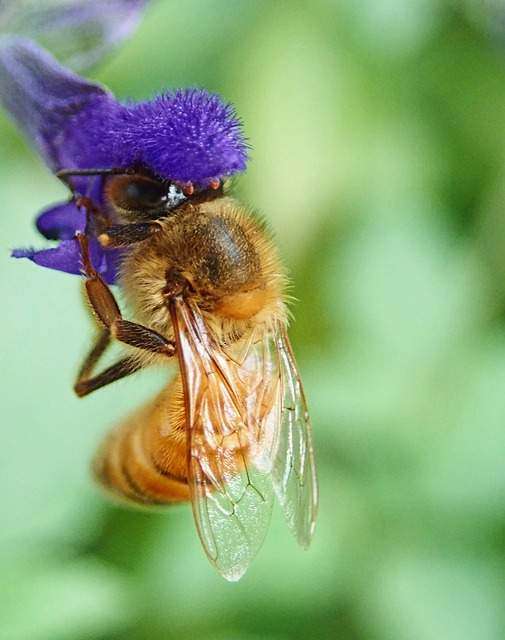
How do you tell if bees are bringing in nectar?
- The amount of activity and the number of bees foraging is the most evident indicators. While other bees are flying off to obtain even more honey, other bees will return to the hive completely loaded with nectar.
Is nectar full of sugar?
- Although it also contains small amounts of proteins, salts, acids, and essential oils, nectar is mostly a watery solution of the sugars fructose, glucose, and sucrose. The percentage of sugar varies from 3 to 80% depending on the type of plant, the soil, and the air.
How do bees reach their hive after collecting nectar?
- She stores the nectar in a honey sac, which functions as a second stomach until she goes back to the colony. Worker bees in the hive get the nectar load, which they then use to fill their proboscis with nectar that they suck from the honey sac.
What flower has the sweetest nectar?
- Borage. Borage is sometimes referred to as a starflower because of its lovely blue blossoms that resemble stars and are liked by both humans and pollinating insects. Borage also offers a lot of delicious nectar, which is ideal for bees.
Is nectar good for health?
- Agave nectar is probably not the best choice if you need to increase the sweetness in your diet. Stevia, erythritol, and xylitol are a few natural sweeteners that are significantly healthier alternatives. In actuality, normal sugar appears healthy compared to agave nectar, which may be the least healthy sweetener on the planet.
Should you feed bees during a nectar flow?
- Even bees can be lethargic; nevertheless, they typically stop when the nectar flow is active. Pull the feeders when you see foragers returning to the hive with full pollen pouches.
How long does it take for nectar to turn into honey?
- Each bee develops a particular function throughout the 45 days it takes to produce honey. The right development of the process and, as a result, the production of high-quality honey is thus guaranteed through teamwork.
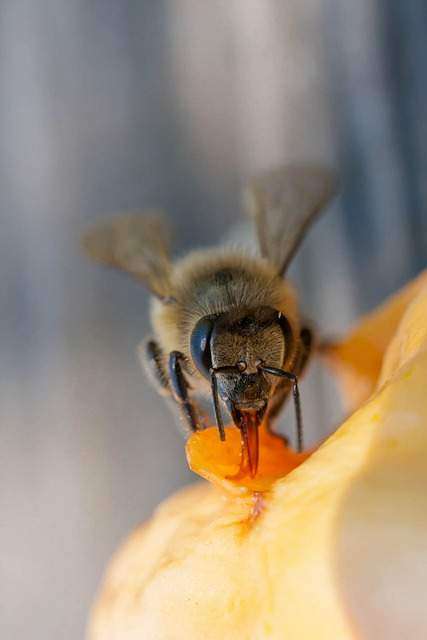
Can bees have too much nectar?
- According to a study, bees become less active when nectar contains too much sugar. The nectar that bumblebees consume from flowers is expelled via vomiting, but the more sugar there is in the nectar, the thicker and stickier it becomes, requiring more time and effort on the part of the bees to do so.
Who converts nectar into honey?
- In order to remove the liquid from the nectar, the bees use their wings. We have honey, a stable and all-natural component produced by bees and used as food, which contains 17% water. Naturally, honey bees create more honey than they use.
Do bees get drunk on nectar?
- Because they drank too much-fermented nectar, bees, especially honey bees, are susceptible to becoming intoxicated. This happens as the nectar heats in the summer heat and starts to smell a little bit bad.
How do you tell if bees are bringing in nectar?
- The amount of activity and the number of bees foraging are the most evident indicators. While other bees are flying off to obtain even more honey, other bees will return to the hive completely loaded with nectar.
